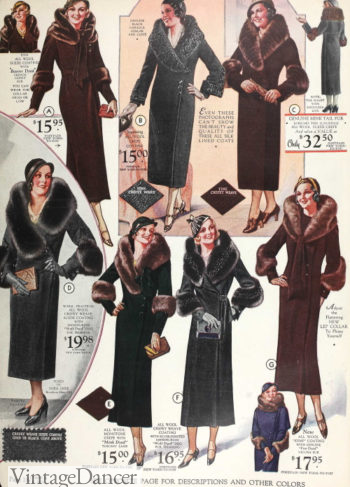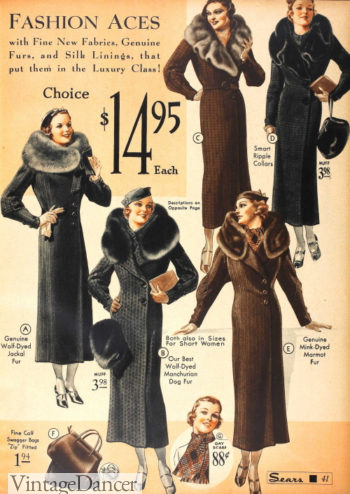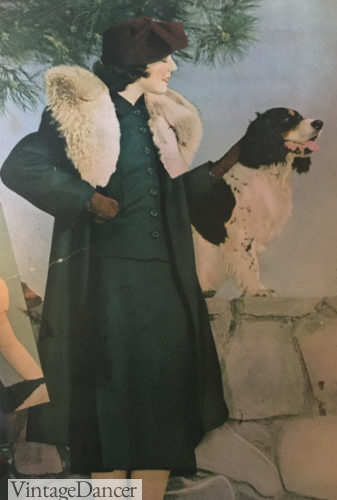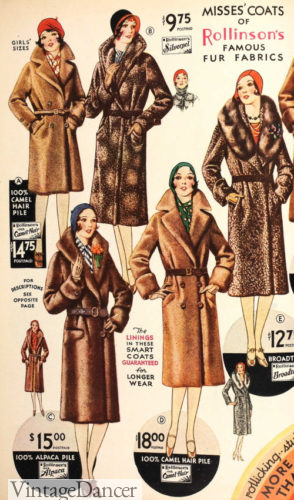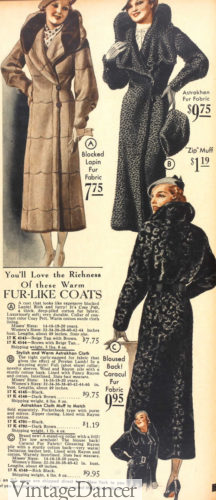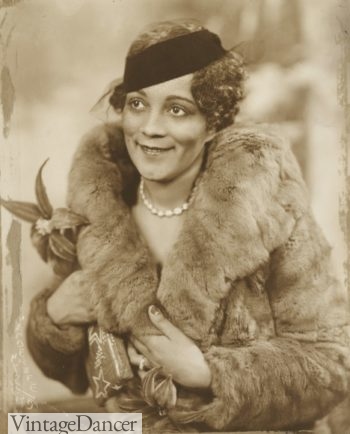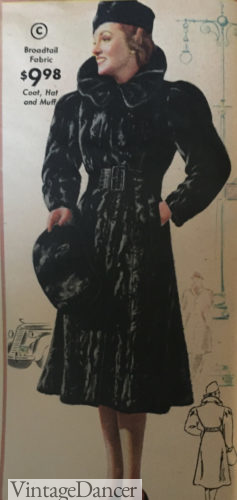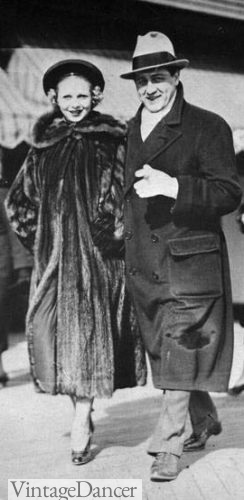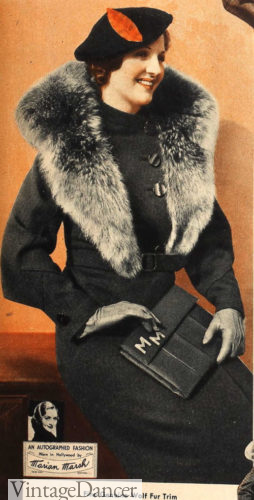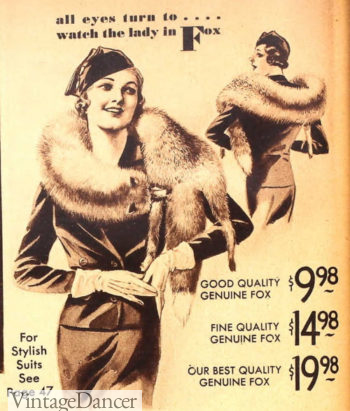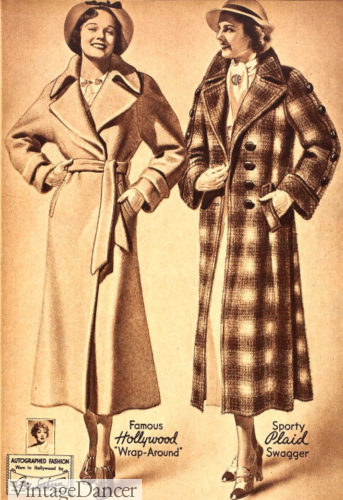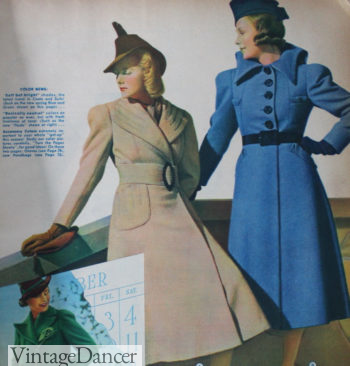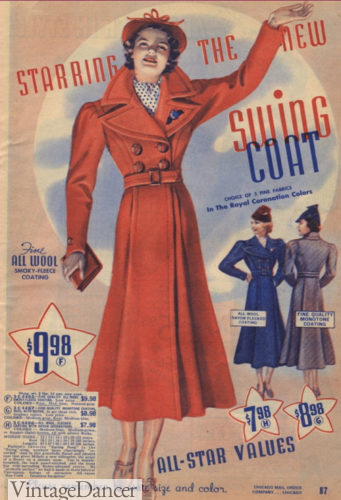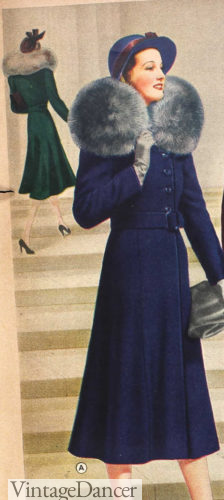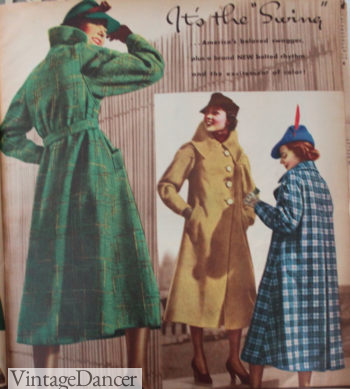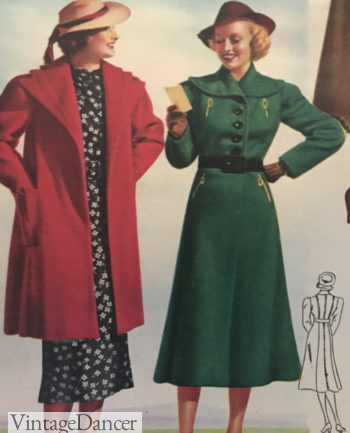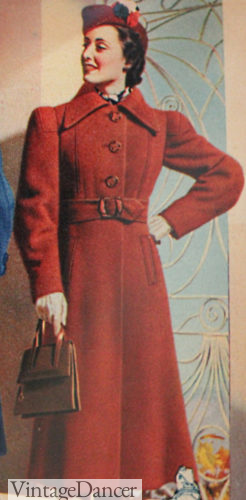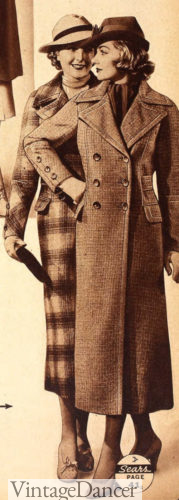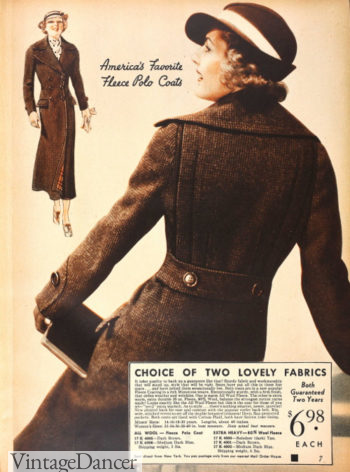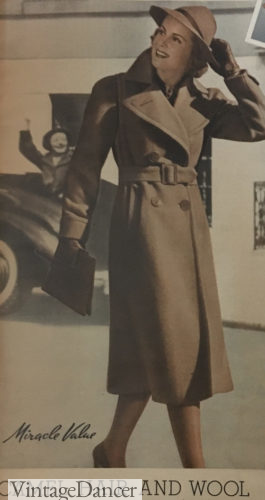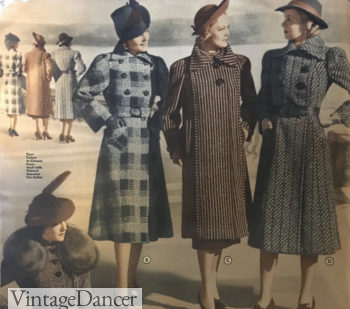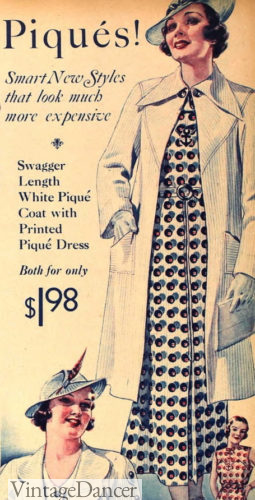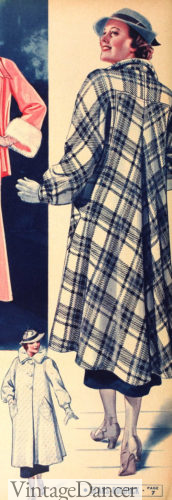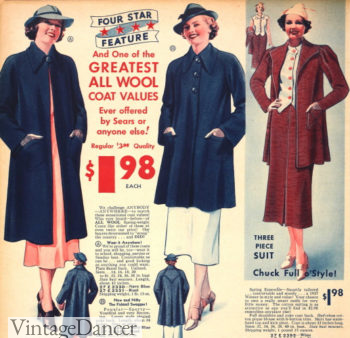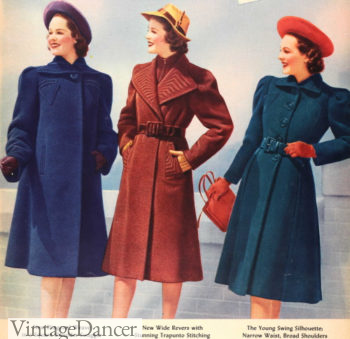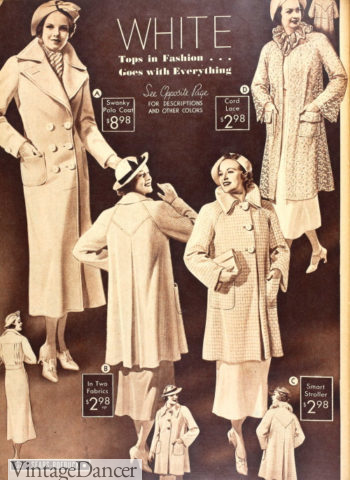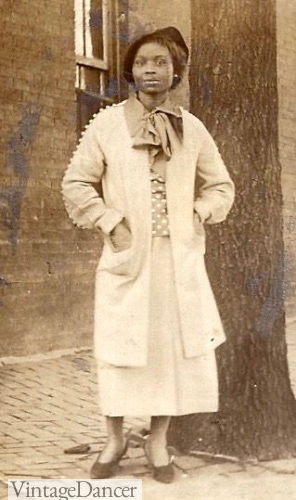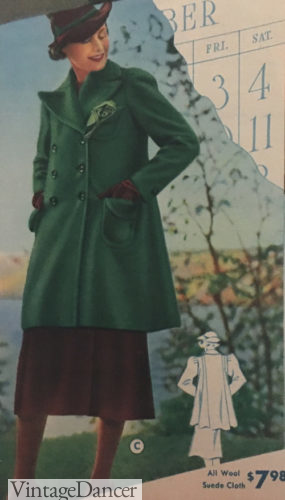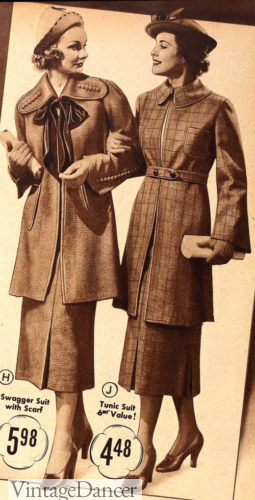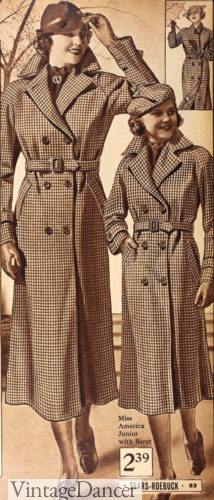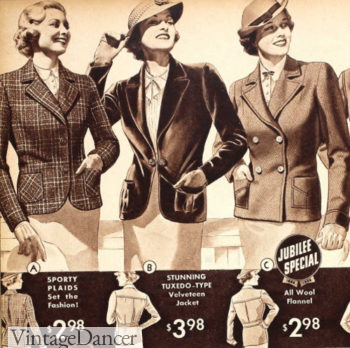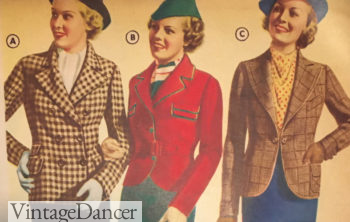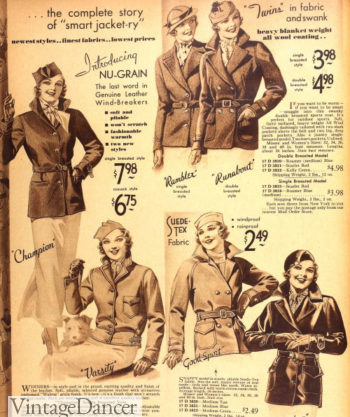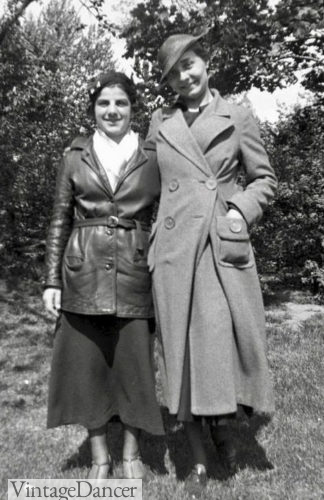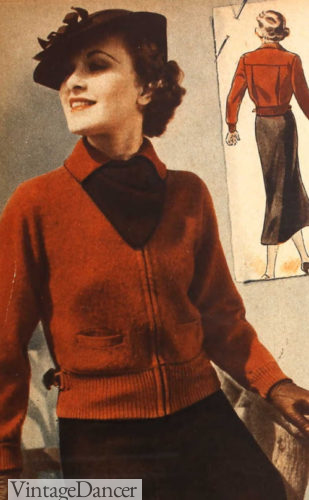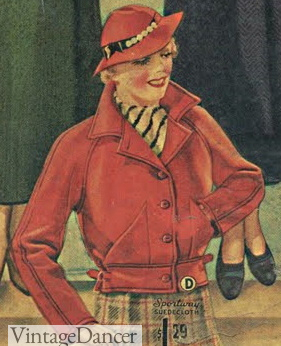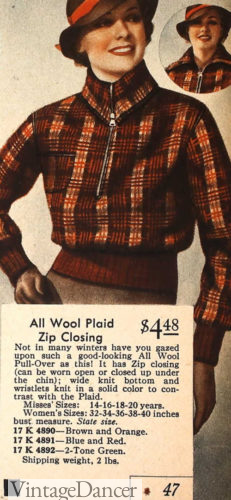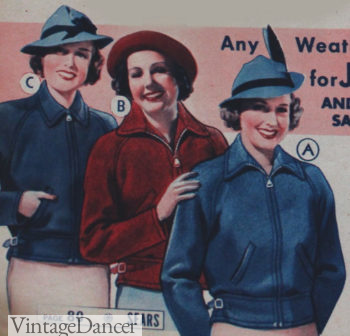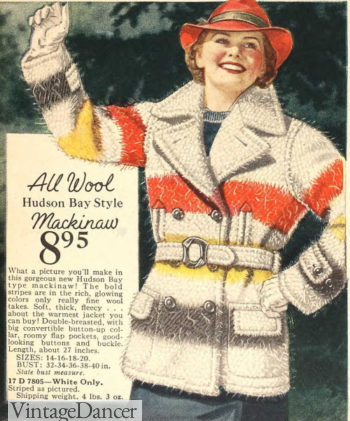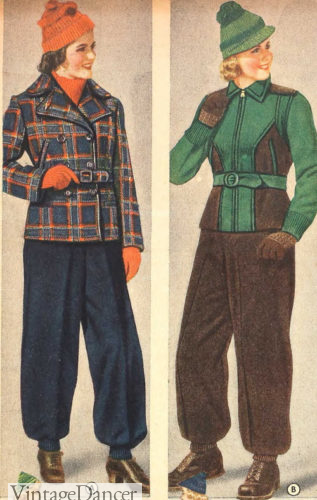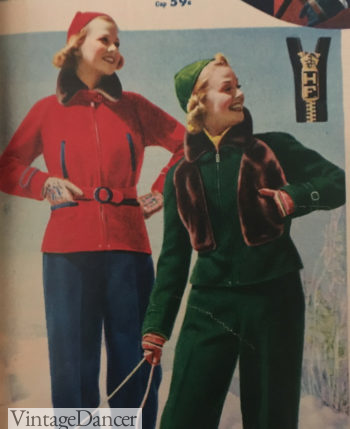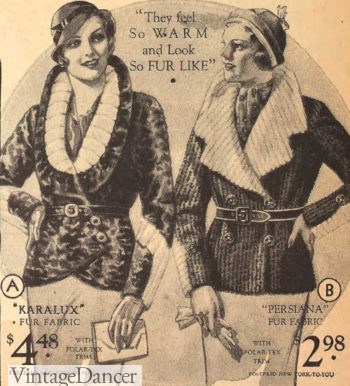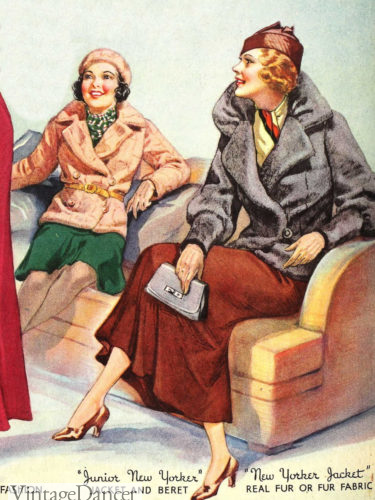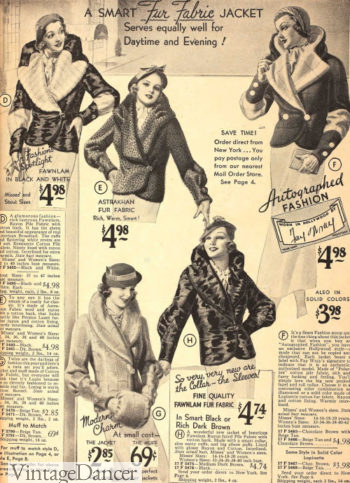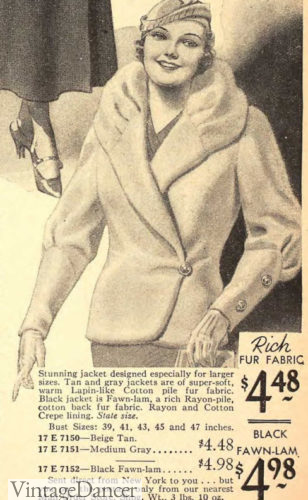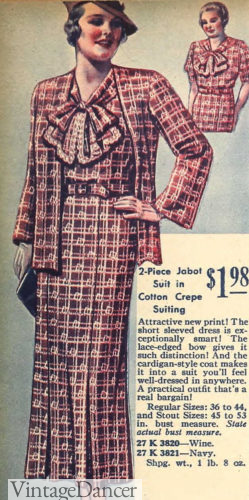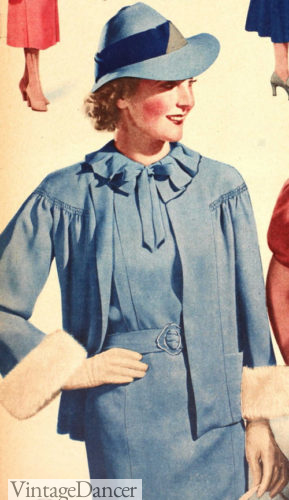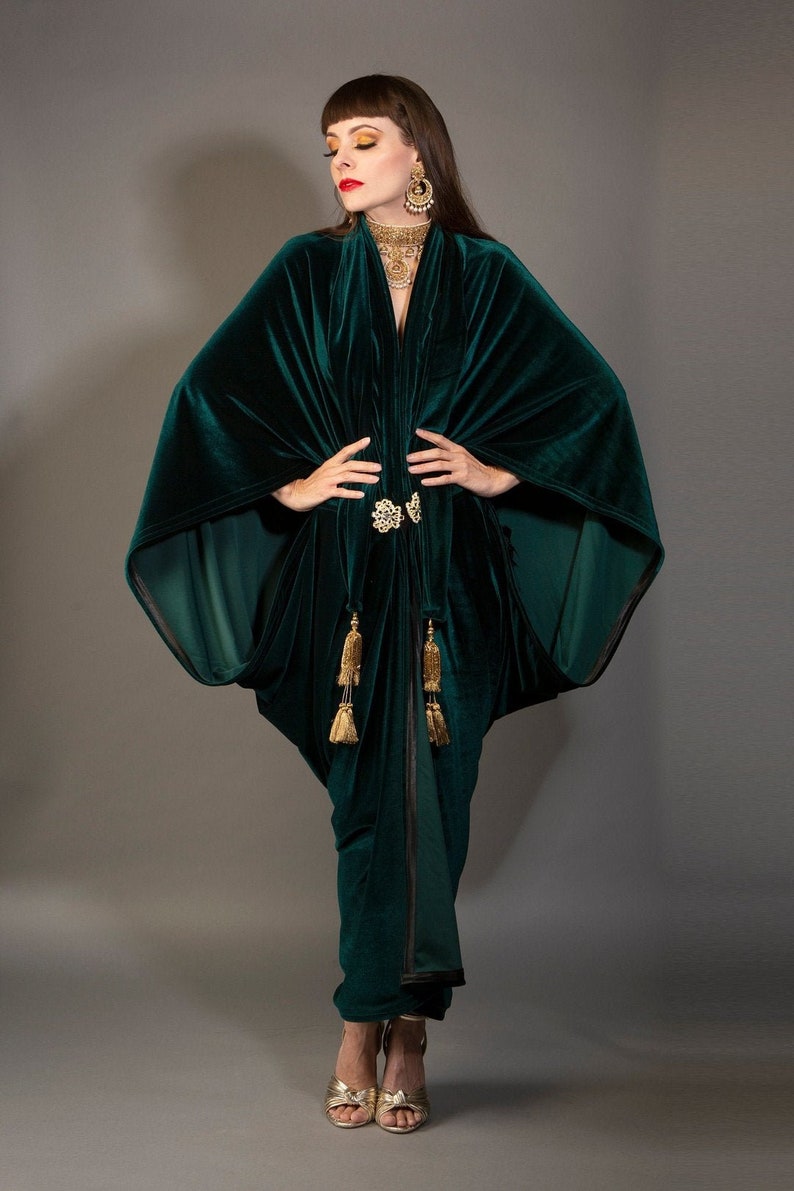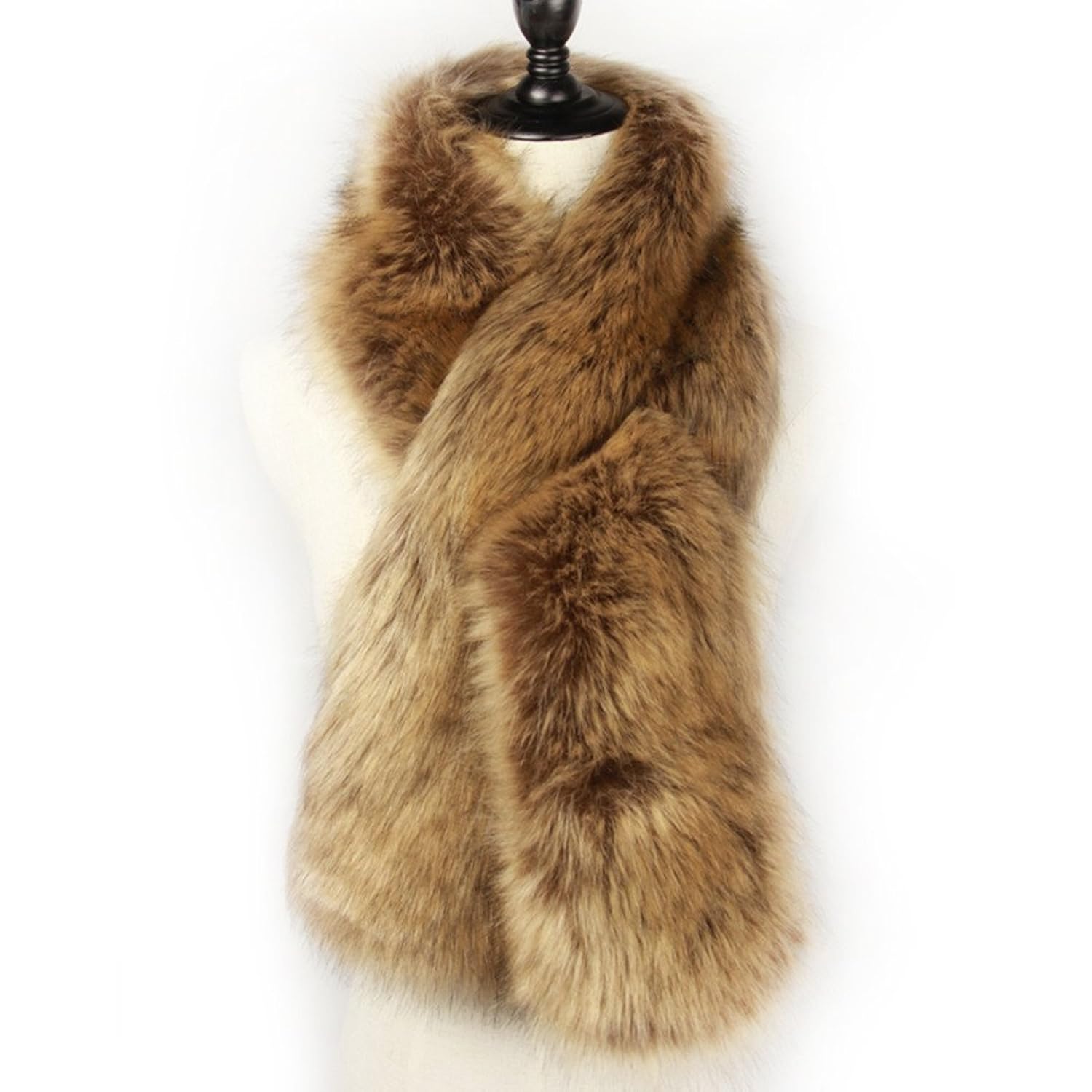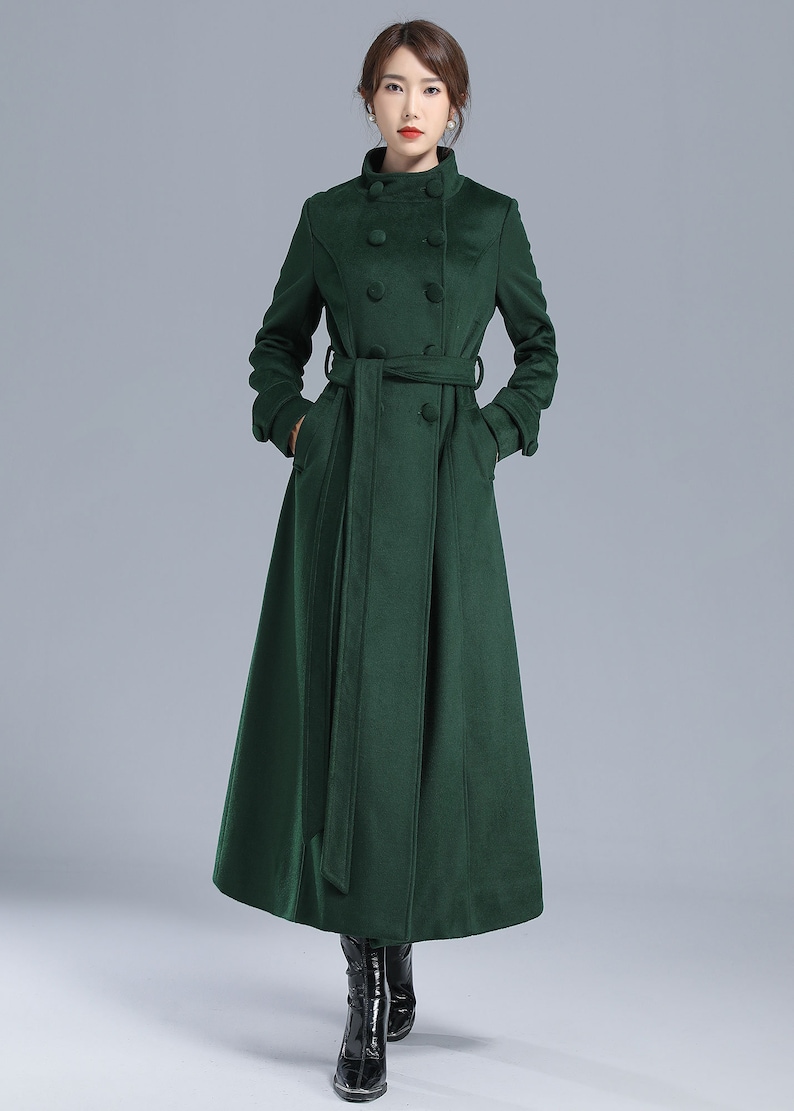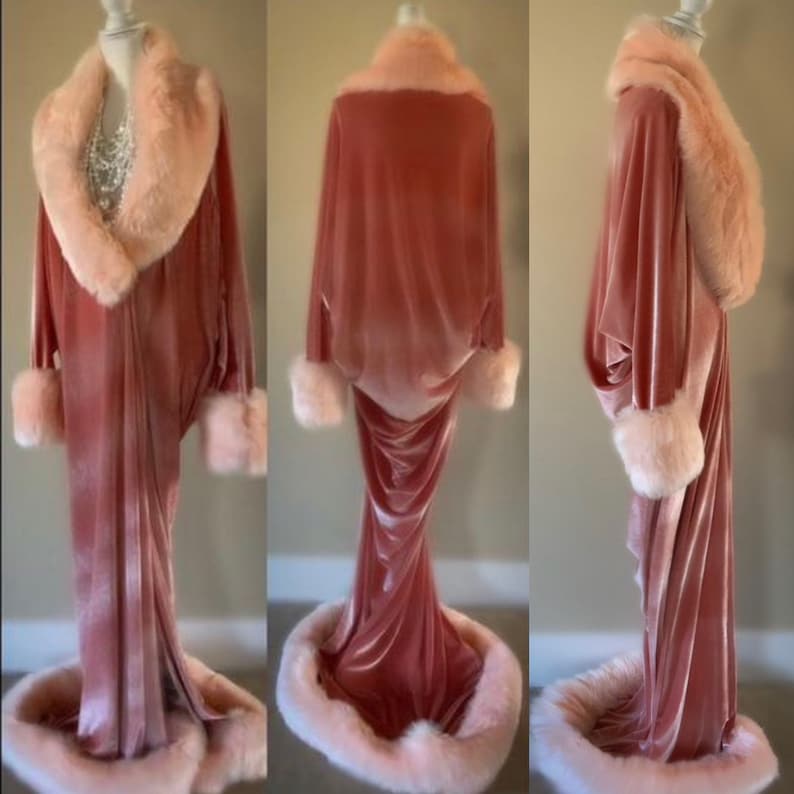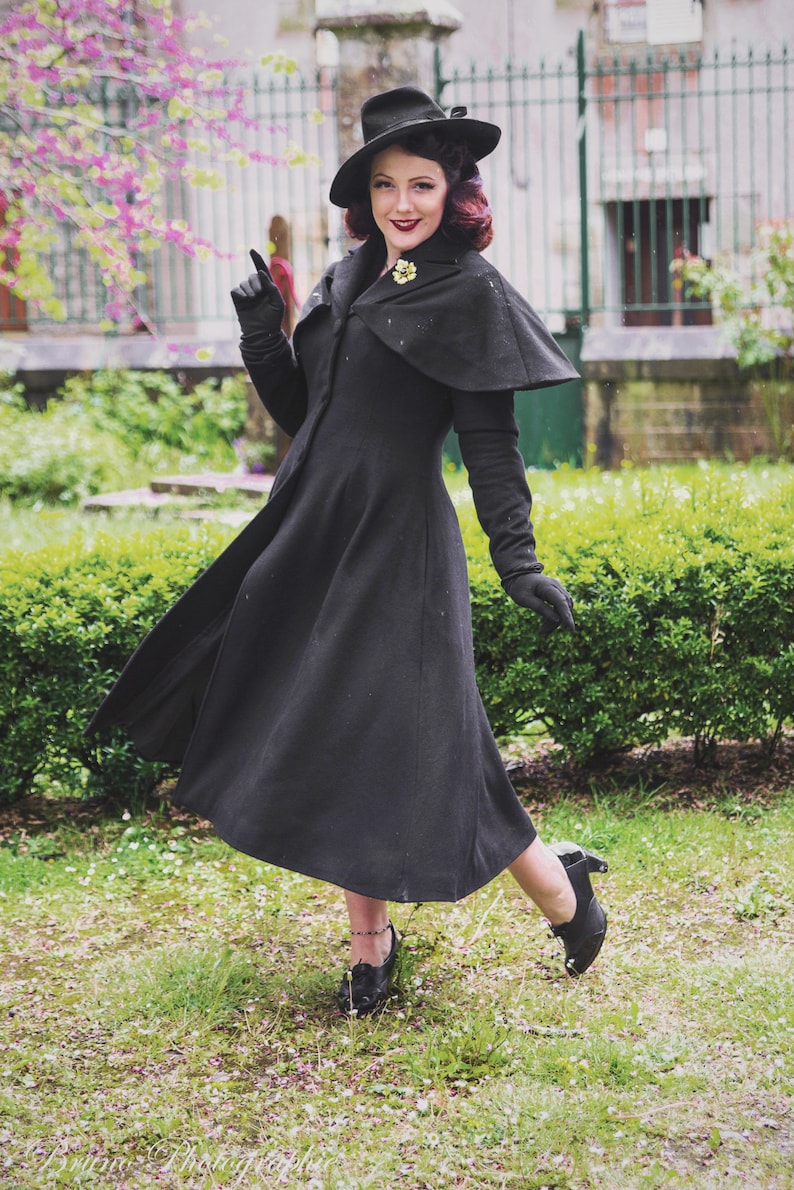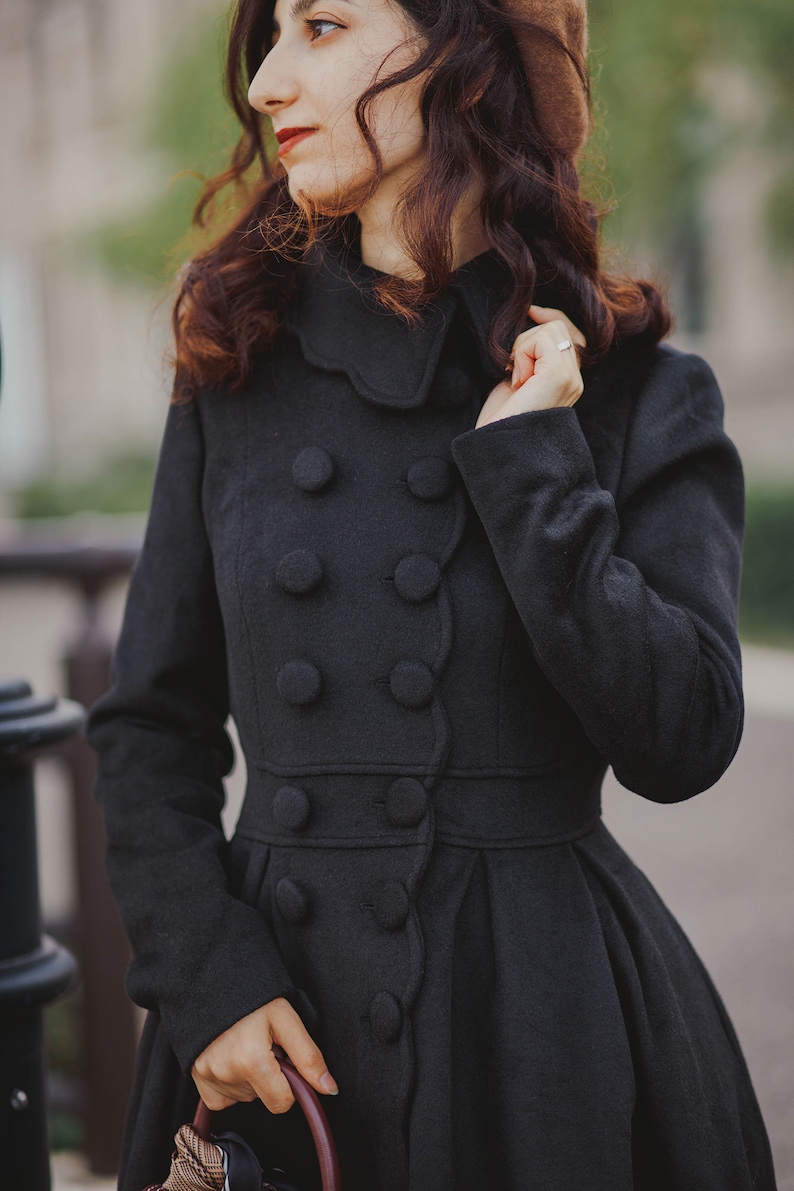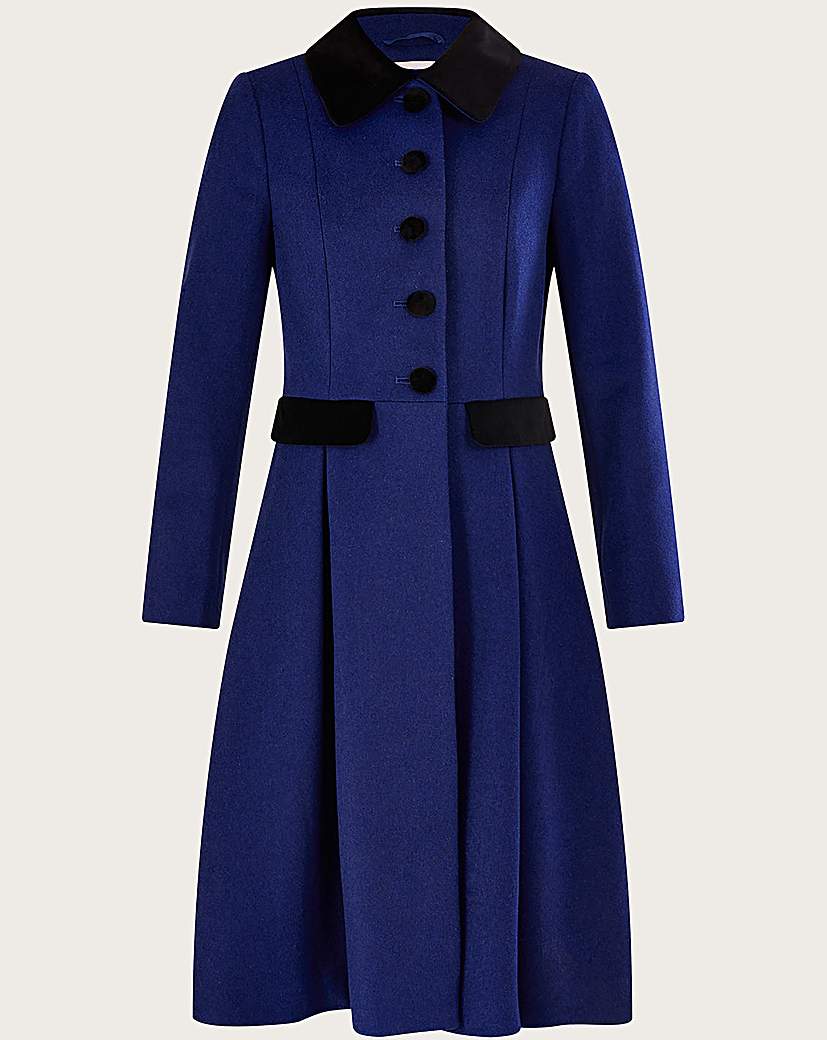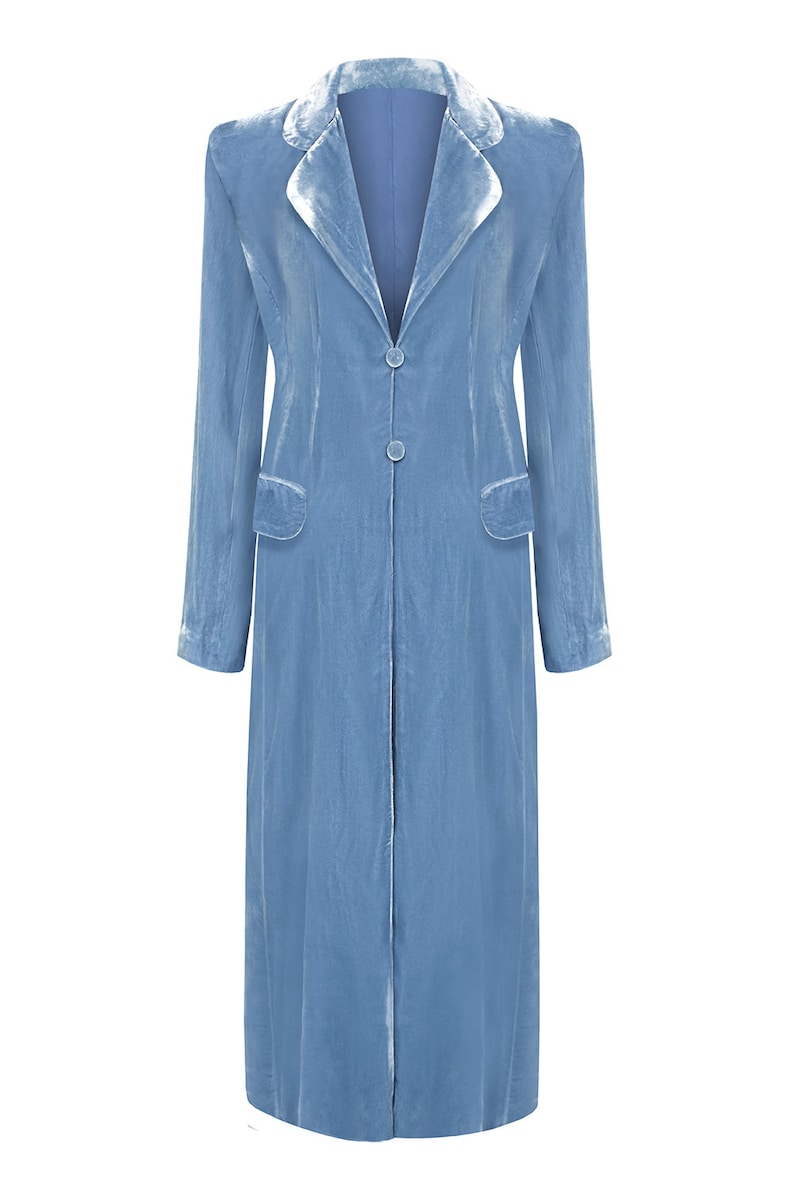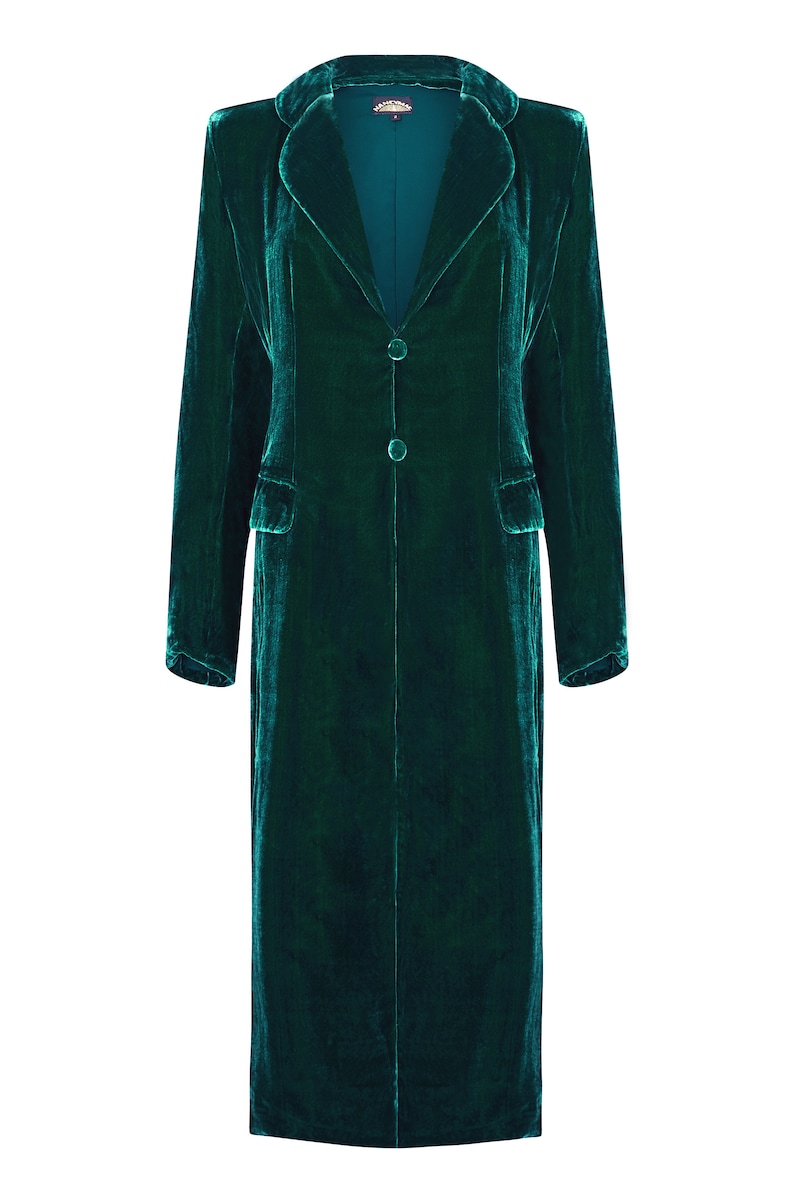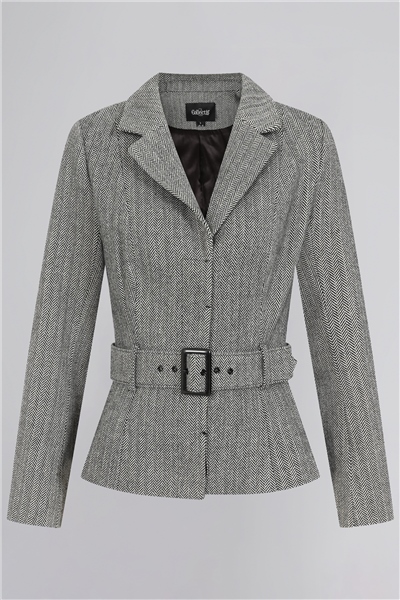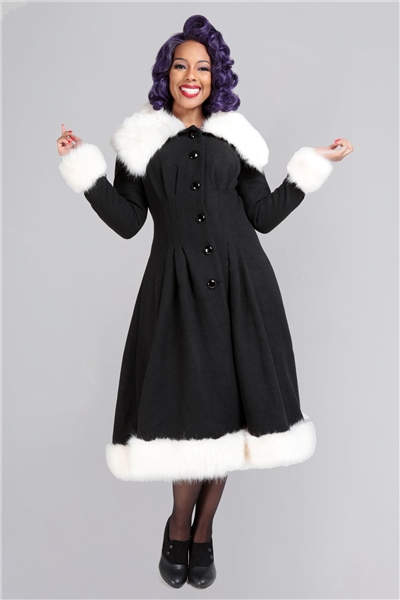Women’s 1930s coats were shaped to follow the natural curves of the female body — a change from the oversized boyish figure of the 1920s. Waists were defined with belts or tapered cuts on princess lines. The hemlines dropped to just above the ankle after 1931, and gradually moved up to the knee by the 1940. Oversized round fur collars topped most coats, just as they did in the 1920s. Military details, influenced by Schiaparelli’s soldier collection, appeared in the form of epaulettes and padded shoulders in the middle years. Oversized pagoda sleeves and some leg o’ mutton shaped shoulders emerged in the middle years too. As hemlines shortened, coat skirts widened and the swagger back loosened up into the hourglass silhouette.
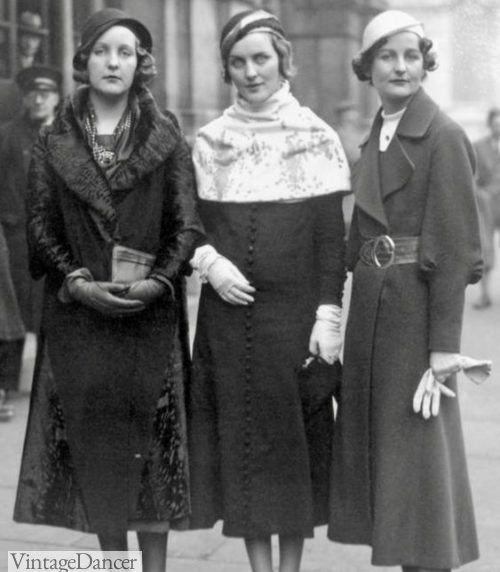
Early 1930s coats
There were a few different categories of women’s 1930s coats and casual jackets. Dress coats were the prettiest and richest looking with large fur collars. Sport coats were man-ish with large peak lapels, wide belts, and fabric patterns. Raincoats were similar to sport coats but in showerproof materials.
Casual jackets topped many spring dresses, as well as fitted blazer type jackets worn with skirts or layered over dresses. The all-fur short jacket was the epitome of classy style for the first half of the decade. Leather and suede sporty aviator style jackets were ideal in spring. The luxurious bunny fur jacket was one style to cross over from day to night.
All of these 30s coat styles and more are showcased in this roundup of 1930s coats and jacket images.
1930s Dress Coats
Every woman had a nice dress coat. If she could afford one with a large round fur collar or a faux fur collar stole, she was fashionable in all kinds of weather. Non-fur collar dress coats included the boxy coat, swagger coat, wrap coat, and swing coat/princess coat.
Fur collar coats
- 1932 fur collar coats (semi shawl)
- 1935 fur collar coats (round and high)
- 1938 white collar on a maroon princess coat
- 1938 cream fluffy fur collar on a green box coat (cute dog!)
Fur Coats
All fur coats were very expensive and weren’t often sold in the cash poor Depression Era, yet they were available in soft medium length furs and faux furs. Black was the best choice, followed by tan colored furs. They mimicked the same shapes as other dressy coats, top coats, swagger coats, wrap coats, and box coats. At the end of the decade, the fur trim coat was a charming new addition.
The wearing of fur pieces or whole animal stoles was still common in the early 1930s. It was a more affordable way to add fur to plain coats.
- 1930 fur coats
- 1935 faux fur coats
- 1935 Lady with Fur Jacket by James Van Der Zee
- 1938 black fur belted coat
- Mae Capone’s box fur coat
- 1938 red fur trim coat
- 1935, A fur stole/piece worn over a coat
- 1934 Whole fox fur stole
Wrap Coats
Wrap coats with overlapping panels and a tie belt lost popularity in the 1930s. The few that survived could either be made in a sport style or a dressy style. Some version used a wide slide buckle belt instead of the traditional tie. They started to come back in fashion in the last year or two of the thirties.
- 1935 wrap coat and swagger coat in sport styles
- 1938 wrap coat with belt and blue princess coat
Swing Coats
As hemlines shortened and skirts became a little fuller, the swing coat was born. From the front it was still a slim coat, with only a slightly fuller skirt around calf length. In the back, however, extra panels added volume so that the coat had a swinging action when a woman walked. Swing coats referred only to the skirt — the upper body could be a polo, princess, reefer or other classic belted dressy or sport winter coat. Swing coats are often mixed up with beltless swagger coats, which we will discuss a bit later.
- Polo swing coat
- 1938 princess cut swing coat
- 1937 swing back coats or swagger coats
- 1938 green swing coat and red swagger coat
Princess Coats
Besides the fur collar coat, the princess coat was the next in line for most iconic to the late ’30s. It featured a high button up front with a wide belt, large fold out collar, and a puff shoulder sleeve. The skirt was A-line when paired with the swing style.
- 1938 red princess coat
- 1938 maroon princess coat (R)
Sport Coats
Sport coats differed from dressy coats through the use of textured fabric and collar treatment. Sport coats had very wide menswear style notch or peak lapel collars that could be flipped up and around the neck. Fabrics could be textured, in suiting patterns, or big prints like plaid. Tweed, checks, and herringbone in brown, tan, or blue were common.
Polo coat
Polo coats were the most popular sport coat. They had military accents such as button on the cuffs, epaulets, and belt back. They were usually not belted. They were a precursor to the trench coat as we know it today.
- 1936 polo coats
- 1936 polo coat (swagger in the center)
- 1935 tweed polo coat with belt back
- 1938 camel hair polo coat
Reefer coats
Reefer coats became trendy with the young teen and collage girls in the late 1930s. They combined the wide lapels of the polo coat and high collar of the princess coat with a double row of 3 buttons on the torso, topped with a belt. Solid colors with contrasting buttons were equally as popular as sporty plaid, tweed, check, and herringbone fabrics. By 1938, the reefer diversified into a style with only two side by side buttons and no belt — a style which was to dominate the 1940s market.
- 1938 plaid and tweed reefer coats (box coat in the center) at VintageDancer
- 1938 two button reefer coat at VintageDancer
Swagger coat
Swagger coat. What a fun name for a new coat invention. The inverted pleat back on the swagger coat gave it plenty of volume and “swing” while the front lacked buttons or belts. A single button at the neck was all it needed to stay in place. It was ideally worn in spring, with a light weight cloth that had more movement. In winter, it could be made of heavier cloth in shorter stroller lengths.
- 1936 spring white swagger coat
- 1936 plaid swagger coat
- 1937 swagger coats
- 1939 blue swagger coat
Stroller Coat
Spring coats, usually sold with matching suits and dresses, were straight and boxy instead of curvaceous like most winter overcoats.
Stroller coats referred to the length of a coat. They could come in the swagger style with a single neck button or with several buttons down the front. Lengths varied from thigh to knee.
- 1936 white stroller coats for spring
- 1936 White Stroller Coat
- 1938 winter stroller length coat
- 1937 stroller length coats and suits
Raincoats
Early 1930s raincoats resembled men’s trench coats or polo coats with bold check patterns in neutral tan-brown colors.
A new form of colored rainwear was made of Philofilm, a clear rubber resembling vinyl that was used to make transparent colored rain coats, hooded caps, and umbrellas. Read more about vintage rain coats here.
- 1936 check rain coats
- 1937 clear colored rainwear
1930s Jackets for Women
The sports jacket or casual jacket emerged in the 1920s but took off in the 1930s. They were worn with dressy suits, separates, casual sport clothes, and sometimes evening attire.
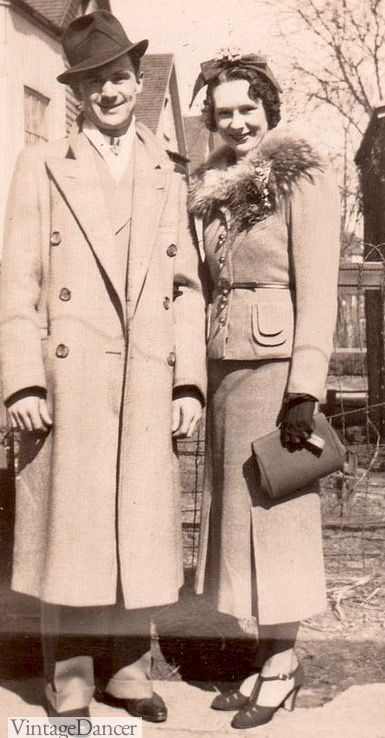
1937 short jacket with fur collar
Blazer Jackets
Traditional menswear sportscoats were paired down into blazer type jackets for women. They fit snug through the waist and over the hips. Both single breasted and double breasted jackets were worn in bold solid color or plaid patterns. The velvet “tuxedo” jacket was one fabric that could cross over from day to night.
- 1936 dressy jackets
- 1937 blazer jackets
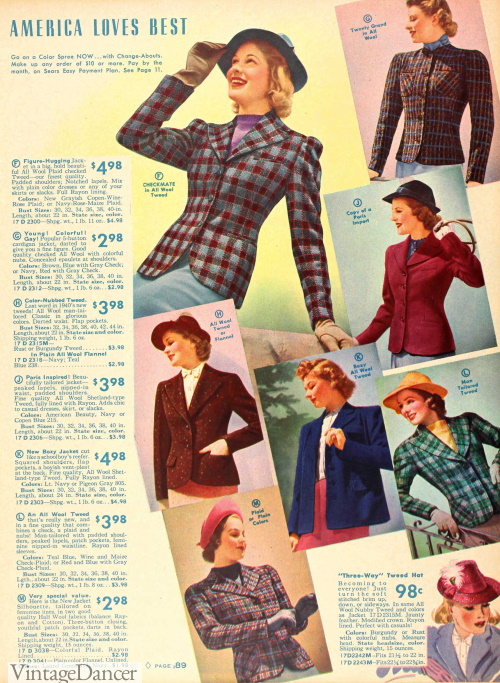
1939 blazer jackets
Leather Jackets
Leather and suede jackets took inspiration from aviator flight jackets. Amelia Earhart was hero to many women, and her clothes were copied into women’s mainstream looks. Most leather jackets were short hip-length polo coats with wide lapels, a belt, and two flap pockets.
- 1933 fabric or leather jackets
- 1930 leather sport jacket and polo overcoat
Sport Jackets
More women’s jackets were copied from men’s casual jackets and slimmed down into feminine proportions. The zip up bomber jacket became the ladies’ crop jacket with either a banded waist hem or cinched buckles on the sides (Cossack style).
- 1935 full zip wool jacket
- 1935 red wool button up jackets
- 1935 plaid half zip jacket
- 1937 cosack jackets
Mackinaw Jackets
Winter outdoor jackets continued to favor the mackinaw jacket. Like leather jackets, they were essentially the shape of a hip length polo coat with a belt, and always in a bold plaid or blanket-cloth wide stripes. Many ski jackets also followed the mackinaw shape or the zip sport jacket.
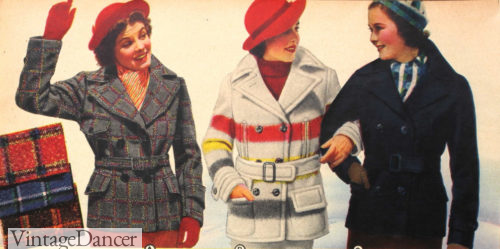
1937 mackinaw jackets
- 1935 plaid mackinaw jacket
- 1936 blanket cloth striped mackinaw jacket
- 1938 ski pants and belted jackets
- 1938 ski jackets
Fur Jackets
Short fur jackets with oversized collars, a wrapover front, and a small belt or covered button was a classy (and sporty) piece to wear in the early ’30s. It paired equally well with a smart suit or an elegant evening gown. Tan, grey, or black with white trim were the color choices. “Bunny fur” was the softest and most affordable fur, dyed to look like expensive furs.
- 1932 black and white fur jackets
- 1933 short winter jackets
- 1934 sporty and classy fur jackets
- 1934 fur jacket for plus sizes
Dress Jackets
Many spring dresses were sold with a matching light jacket that hovered around the top of mid hip. They were worn draped over the shoulders, exposing the dress bodice.
- 1935 check dress with jacket
- 1936 blue dress with short jacket
1930s Style Coats and Jackets
Today many long vintage-style overcoats are back in style. So are short crop jackets and leather moto jackets. Many of these will make acceptable ’30s coats and jackets for vintage-inspired outfits. The fur collar coats remains elusive, so I recommend purchased a separate fur collar (vintage) and attaching it to a regular coat.
Here are the coats and jackets I found that have a 1930s look:
Debbie Sessions has been teaching fashion history and helping people dress for vintage themed events since 2009. She has turned a hobby into VintageDancer.com with hundreds of well researched articles and hand picked links to vintage inspired clothing online. She aims to make dressing accurately (or not) an affordable option for all. Oh, and she dances too.
